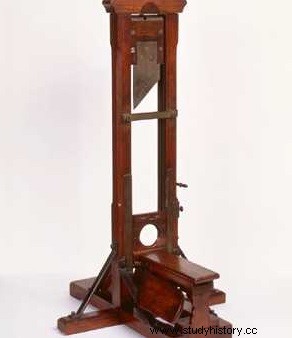 With the Revolution appears a new machine for the application of capital punishment:the guillotine . It owes its name to Doctor Guillotin, a member of the Constituent Assembly, who in 1789 proposed to replace by beheading the punishments then in force for those condemned to death. He advocated the use of a machine whose concept had been imagined a few years previously. The guillotine operated for the first time in France on April 25, 1792 and will be used until 1977.
With the Revolution appears a new machine for the application of capital punishment:the guillotine . It owes its name to Doctor Guillotin, a member of the Constituent Assembly, who in 1789 proposed to replace by beheading the punishments then in force for those condemned to death. He advocated the use of a machine whose concept had been imagined a few years previously. The guillotine operated for the first time in France on April 25, 1792 and will be used until 1977.
The origins of the guillotine
Many modes of execution existed before the Revolution. The application of the death penalty varies according to the crime and the conditions of its realization. The executioners thus resort to beheading with a sword when it comes to nobles; to the gallows, stake or wheel for commoners; to the quartering for the regicides.
With the Revolution, mechanical decapitation was imagined as early as October and December 1789. In two speeches by Dr. Joseph-lgnace Guillotin delivered to the Constituent Assembly, the he idea of using a guillotine is proposed, in particular because of the immediacy of the punishment. He considers this method more "humane" than hanging or beheading with an axe, which can be time-consuming.
Doctor Guillotin
 Joseph-lgnace Guillotin was a doctor and deputy of Paris in 1789. It was within the framework of this function that he proposes a device consisting of a large straight frame (4 m high), from which is suspended a triangular cleaver which cuts off the head of the condemned person by severing his neck. During an execution, the executioner pushes the body abruptly against the board called “seesaw” which turns forward by a quarter of a circle and comes to rest in a horizontal position, the face of the condemned man looking at the ground. The throat rests on the lower part of the "glasse" notched in a semicircle, then the upper part immediately falls on the nape, immobilizing the neck. The guillotine knife, weighing approximately 50 kg, is then released and falls in a straight line. According to Doctor Guillotin, the condemned person must feel "at most, the impression of a cool breath in the back of the neck".
Joseph-lgnace Guillotin was a doctor and deputy of Paris in 1789. It was within the framework of this function that he proposes a device consisting of a large straight frame (4 m high), from which is suspended a triangular cleaver which cuts off the head of the condemned person by severing his neck. During an execution, the executioner pushes the body abruptly against the board called “seesaw” which turns forward by a quarter of a circle and comes to rest in a horizontal position, the face of the condemned man looking at the ground. The throat rests on the lower part of the "glasse" notched in a semicircle, then the upper part immediately falls on the nape, immobilizing the neck. The guillotine knife, weighing approximately 50 kg, is then released and falls in a straight line. According to Doctor Guillotin, the condemned person must feel "at most, the impression of a cool breath in the back of the neck".
The “national razor” at work
The guillotine went by several nicknames during the Revolution. She is called "Louisette", "Louison", "great national razor" or even "the Widow". She began her work on April 25, 1792 with the performance of Nicolas Jacques Pelletier. It works enormously during the revolutionary phase (Louis XVI, Marie-Antoinette, Robespierre or Danton will be condemned to it). Contrary to what one might think, aristocrats and politicians only represent a small percentage of those who passed through the hands of the executioner Charles-Henri Sanson:it was the workers and peasants who paid the heaviest price. at the Sainte Guillotine (60% of the more than 16,000 condemned).
The guillotine will remain in operation until 1977.
To go further
- The Cleaver of Eternity:History of the Guillotine, by Sylvain Larue. Bonneton, 2021.
